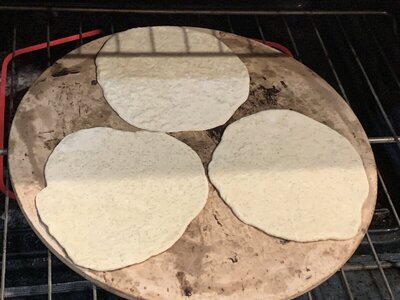The Late Night Gourmet
Home kook
- Joined
- 30 Mar 2017
- Local time
- 1:57 AM
- Messages
- 5,778
- Location
- Detroit, USA
- Website
- absolute0cooking.com
I bought some hummus at the market, and I naturally wanted pita bread to dip in the hummus. But, the only kind they had was the flat, pocket-type pita bread. So, I made some. And, yes, I am aware that pita means flatbread, so it's a bit redundant to call it pita bread. But, just calling it pita sounds like a name, so I find myself calling it pita bread.
But, enough of the exciting back story of this recipe. When I've made a pita (bread) in the past, I've done so in a pan on the stove, once in a cast iron pan. It turned out great. But, I just learned about using a pizza stone shortly before I made this recipe, and I decided to give it a try. I loved the results, since it gives the bread a chance to rise before it has a chance to burn. And, I haven't used my pizza stone in over a year, so it was good to use it again.
And, about, the choice of flour. I have seen pita recipes with only all purpose flour, and I have made it that way before. They're good, but they miss something when compared to the genuine article that I had while in Athens. Most recipes mix in wheat flour, but I went with buckwheat. It's subtle, but I like the nuttiness of buckwheat flour here.
Finally, the salt content. My wife and son both said that it tasted "a bit salty", but in my opinion it was simply that they aren't used to pita bread having a flavor. I get that bread is supposed to be a neutral backdrop to other tastier things, but I like how the salt brings out the flavor of the bread.
Ingredients
1 packet instant yeast
1 cup warm water
1/2 teaspoon sugar
1/4 cup buckwheat flour
2 tablespoons olive oil
2 1/2 cups all purpose flour
1 1/2 teaspoons kosher salt
Directions
1. Mix yeast, sugar, buckwheat flour, and warm water together in the mixing bowl. Allow to proof at room temperature for 10 minutes, until the surface get foamy. Note the beautiful spots from the buckwheat flour.
2. In a mixer equipped with dough hooks, blend in the all purpose flour a little bit at a time, scraping down the sides of the mixer from time to time. Once all the flour is added to the bowl, and just started to combine, stop the mixer to prevent overmixing. Turn out the dough onto a generously floured surface, and knead by hand until the flour is fully combined with the dough. Brush the inside of the mixing bowl with oil. Roll the dough into a ball, place in the bowl, and cover with cling wrap. Allow to sit at room temperature until doubled in size, at least an hour.
3. Turn out dough from bowl onto a generously floured surface. Knead out any dry spots, and divide into 8 equal portions. Roll each portion into a ball, then roll out into a disc shape.
4. Allow the rolled-out discs to sit at room temperature for 10 minutes while heating a pizza stone in the oven to 500°F (260°C). Cover discs with a damp towel, preferably one you bought the last time you were in Greece.
5. Place discs on the pizza stone. Bake for 2 minutes, then flip over. Continue baking until baked to to a golden brown. Serve immediately, or place on a cooling rack for a few minutes, then seal in zipper bag to prevent them from drying out.

Last edited:

